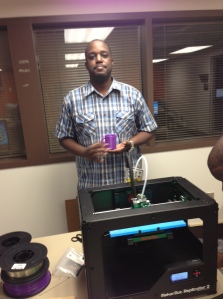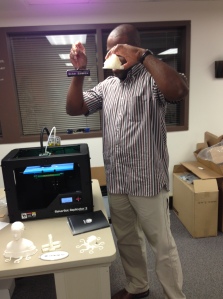Welcome to a new issue of Stew of the Month, a monthly blog from Digital Systems and Stewardship (DSS) at the University of Maryland Libraries. This blog provides news and updates from the DSS Division. We welcome comments, feedback and ideas for improving our products and services.
Digitization Activities
We have received files for the remaining volumes of the University of Maryland Schedule of Classes that were digitized from microfilm; quality assurance will be completed over the next month and they will be uploaded to the Internet Archive. Eric Cartier uploaded 24 volumes of the AFL-CIO News (see photo below for an example with interesting metadata) and 29 volumes University of Maryland Schedules of Classes to the Internet Archive, both held in Special Collections and University Archives (SCUA), and digitized from print and received back last month. These digitization projects were funded through the DIC proposal process.
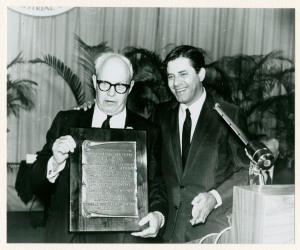
Elizabeth Caringola submitted the sample batch of digitized microfilm for the 2014-2016 NDNP grant. After this sample is approved, she will start production batches of around 10,000 pages. Babak and Liz also submitted the first grant report for the 2014-2016 cycle to NEH and the Library of Congress detailing the progress with the project.
Liz has also been working with her students to promote interesting digital images from digitized Maryland newspaper pages available on Chronicling America by starting a Pinterest board.
Robin worked with Joanne Archer, Anne Turkos, and other SCUA staff to ship 3,446 photographs from the Diamondback newspaper photo morgue to a digitization vendor. This shipment is the first half of the first phase of the two-year project to digitize nearly 18,000 photographs. The project is funded through the DIC proposal process.
Digital Programs and Initiatives
Alice Prael has begun work on updating the current Best Practices for Digital Collections. The new Best Practices will improve the organization and functionality by moving from a standard document to a wiki platform and will be updated to include our newest projects, initiatives, and processes.
Early in the month, Josh Westgard attended the DuraSpace summit in Washington, DC, where discussion focused on Duraspace’s three main products, Fedora, DSpace, and VIVO, all of which are of interest to, or currently in use by the Libraries. He also participated in the community-driven Fedora 4 development process, including helping to draft the requirements for an audit service, and attending, along with colleagues from SSDR and Metadata Services, the DC Area Fedora Users Group meeting at the National Agricultural Library.
Software Development
Development of the new online student application submission form and supervisor database has continued. We have hit a technical snag in our new Wufoo form caused by a limit of 100 fields per form and the way that “fields” are counted so will need to create a workaround. Implementation has begun on the supervisor database and workflow implemented in the Staff Intranet, Libi, implemented in Drupal.
Working with the Library Web Advisory Committee, we have established high-level objectives and major milestones for the Responsive Web Design (RWD) project for the Libraries’ Website. The timeline calls for planning during the Spring, implementation over the Summer, final testing and content updates in the Fall, and release scheduled for January, 2016. We have completed selection of Bootstrap as the RWD framework and Unify as our starting template, based in part on our successful use of both tools in the Beyond the Battle: Bladensburg Rediscovered special collections exhibit. The next step of creating wireframes for key page layouts is in progress.
Hippo CMS received improvements to its Solr Database feature, currently used only by the SCPA Scores Database, laying the groundwork for several new databases, such as SCPA Recording, Maryland Digitized Newspapers, and Plant Patents. Databases are in general chosen to be disseminated using this feature when they have simple metadata and little to no content requirements. This is a lighter weight alternative to full ingest into Digital Collections.
We are finalizing preparations for bringing online the new Fedora Commons Repository version 4. This soft release will target minimal services only, with no data migrated from the existing Fedora 2. By bringing the service up in production well before the full release, we will be able to incrementally test and add new procedures. This will increase reliability and confidence in the service when it comes time to bear the full weight of our digital collections.
User and System Support
In late February, the John and Stella Graves MakerSpace was asked to assist with making a few 3D printed items for an exhibit at the Shady Grove (Priddy) Library in March. Eileen Harrigton requested the 3D printed models of human and hominid skulls as a part of an interactive exhibit on evolution. By 3D printing actual scans of the fossils, attendees were able to pick up the models and get a better and closer look at the skulls.
Interestingly, Archeology and 3D printing/scanning have some things in common. Both utilize careful planning on removal of debris from the item. For 3D printed item, sometimes supports are printed and need to be removed after the printing is finished, a lot like the removal of debris and dirt around fossils.
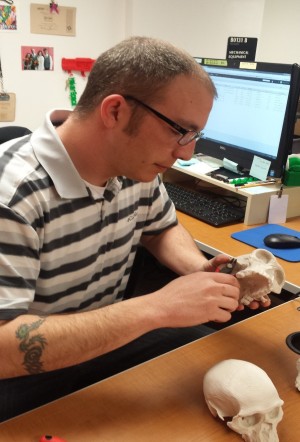
3D scanning is also used in archeological dig sites. It is used to quickly record accurate positional details and measurements before removal, and full 3D scans after the item is removed from the ground.
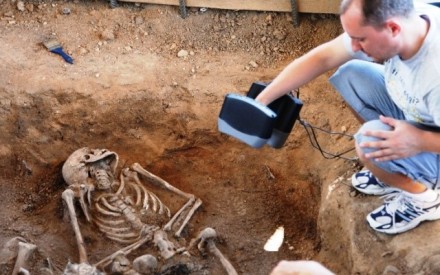
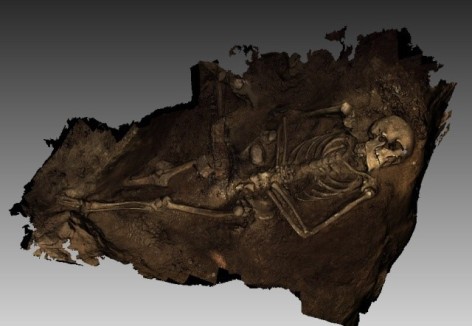
After the scan is complete, it can be imported into a modeling program like Autodesk Design to clean up the scan and make it ready for 3D printing. After the initial cleanup, the file can be exported to a .stl file (stereolithography) and printed.
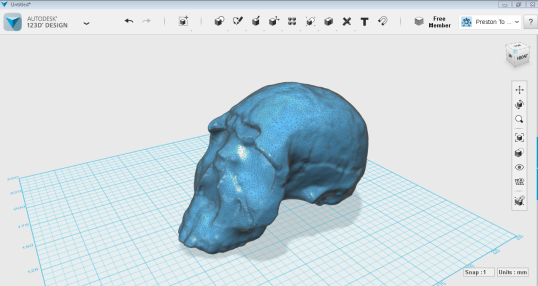
The files that were requested came from a website that has many 3D scanned fossils. (http://africanfossils.org/) The models took approximately 20 hours in total to print and one hour to do finishing details like support removal.
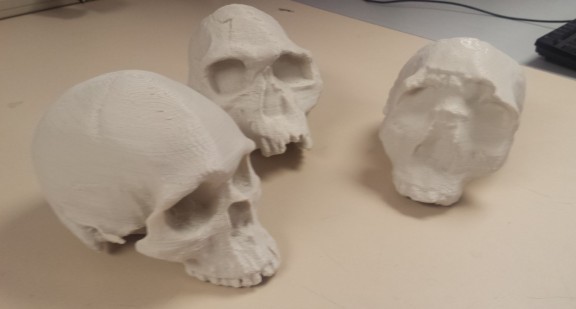
USMAI (University System of Maryland and Affiliated Institutions) Library Consortium
DSS has been working on an exciting opportunity with the consortium and a few other Maryland academic libraries to put together a shared institutional repository (IR). DSS presented a proposal to the consortium for a 2-year pilot, which was accepted. The IR will be named Maryland Shared Open Access Repository (MDSoar, for short). The partners of the shared IR will rely on DSS’ 10+ years of experience managing DRUM. Similar to DRUM, MDSoar will use DSpace as its repository platform. DSS staff are currently working with the IR partners to configure the IR with an anticipated launch date of June 15, 2015.
The CLAS team continues its work on the Kuali OLE initiative, participating in weekly meetings with other OLE implementation partners from around the world and developing a sandbox environment in support of College Park’s and USMAI’s testing and evaluation of OLE. In April, the team will welcome in six consortium volunteers to test and evaluate OLE for its potential as the next ILS for the consortium.
Members of the team also attended the USMAI Next Gen ILS Working Group meeting on March 11th to discuss OLE, Aleph, and the next steps for moving to a new ILS over the course of the next several years.
The CLAS team responded to 101 Aleph Rx submissions and 32 e-resource requests. Additionally, members of the team have worked with campuses on such initiatives as implementing single sign-on at Salisbury, enhancing workflows for reporting library fines and fees to the Bursars’ Office at University of Baltimore, and assisting with the UMBC’s transition to shelf-ready orders from YBP.
Staffing
Mark Hemhauser’s last day in the office was March 13th. He is heading to University of California at Berkeley to fill a role as Head of Acquisitions. We wish him the best and hope that he’ll send some good weather our way!
Conferences, workshops and professional development
Eric Cartier was interviewed by the hosts of Lost in the Stacks, “the one and only Research Library Rock’n’Roll show” on WERK 91.1 FM at Georgia Tech. The episode discussing audio digitization, the WMUC radio station and digitization project, and personal digital archiving aired on April 3.
Robin Pike co-proposed a pre-conference workshop called “Managing Audiovisual Digitization Projects” with consultant Joshua Ranger from AV Preserve and vendor George Blood from George Blood Audio, Video, and Film to the Society of American Archivists. She received confirmation that the workshop will be held on Monday, August 17, 2015 in Cleveland, OH as part of the annual conference pre-conference program.
Graduate Assistants Alice Prael (Digital Programs and Initiatives) and Amy Wickner (SCUA) found out they will be presenting their student poster “Getting to Know FRED: Introducing Workflows for Born Digital Content” at the Society of American Archivists annual conference in August.
Liz Caringola recently achieved certification as a Digital Archives Specialist, a program is administered by the Society of American Archivists. Over the past two years, Liz has taken a variety of workshops and webinars on different aspects of digital archives and sat for the cumulative exam on February 24 in College Park.
Peter Eichman, Bria Parker, Ben Wallberg, and Joshua Westgard attended the Washington D.C. Fedora User Group Meeting on March 31 and presented to the group on the status of our Fedora 4 implementation.
